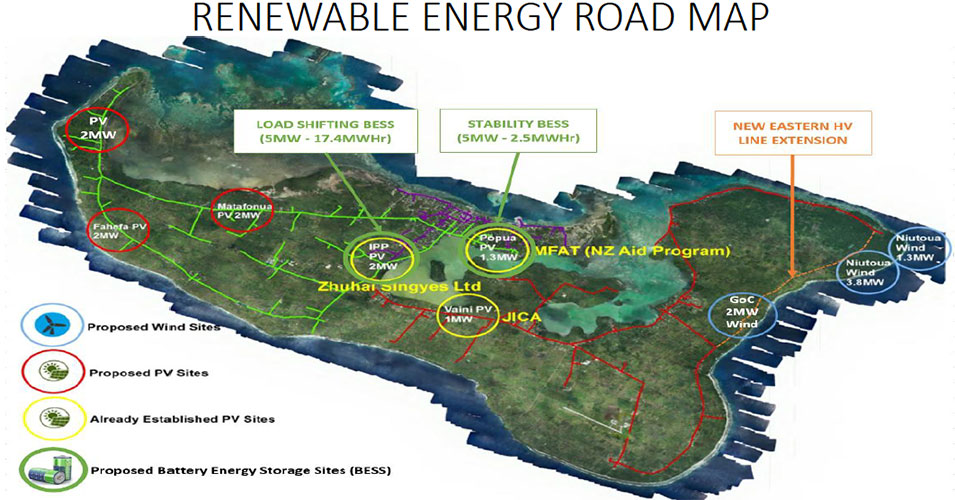
By Eleanor Gee
Tonga’s aim to reach 50% of renewable energy by 2020 is on track, said Tonga Power Ltd CEO, Seti Chen.
“The goal of renewable energy is to reduce our reliance on fossil fuel (diesel),” he told Matangi Tonga.
The 50% target relates to Tonga’s electricity production only, with the aim to transition the country from imported diesel fuel to environmentally friendly and renewable sources of energy under the Tonga Energy Road Map (TERM) 2010-2020. In addition, residents will enjoy some reduction in their electricity bills once the target is met.
Seti said that the amount of diesel used to produce electricity in Tonga is on average just over 1.2 million litres per month or 14.4 million litres per annum. When the 50% target is reached at the end of 2020, this amount is expected to drop to around 7.2 million litres of diesel per annum.
Currently, Tonga produces around 11% of renewable energy annually (including the outer islands).
“On good days throughout the month we can get up to about 16%. Basically, it fluctuates with the weather as well,” said Seti.
Projects
Ongoing and upcoming projects and the larger Tonga Renewable Energy Project (TREP), which received funding from the Green Climate Fund last October, will boost renewable productivity to 50% by the end of 2020.
Three solar plants will be installed on the western (Hihifo) side of Tongatapu. On the eastern side of the island, three wind sites will be installed with one funded by Japan and one by China, and two battery energy storage systems will be installed at existing renewable energy sites close to Nuku’alofa.
The whole of Tonga is projected to consume around 66 gigawatt hours by 2020. Tongatapu alone is projected to consume just over 54 gigawatt hours. But the good news is that Tonga may achieve more than targeted.
“With the projects that we’ve got in place we believe we will actually surpass 50% and reach 54% so half of that is 35 gigawatt hours,” said Seti.
Demand growing
However, the demand for electricity is growing with an increasing amount of electrical appliances such as fans and air conditioning, being used in households, particularly in hot weather.
“The unknown factor for us is the growth, and that’s what we’ve noticed on Tongatapu is that it is actually increasing a lot more than what we actually thought it would.”
"So that will always pose a challenge but right now we’re still sticking with what we’ve benched [marked]," said Seti.
Private investment
In order to reach the 2020 target, private sector investment is being sought to help complete the projects and already there are a number of companies interested.
“The companies that actually are bidding to this are international. There are a lot from Australia, New Zealand, and China. There is a lot of interest in it,” said Seti.
With regards to a reduction in consumers electricity bill, Seti said the direct benefit to all their customers “depends on the feed in tariff we will agree on with the independent power producer when we buy what they have produced whether it be by way of solar or wind or any other private sector investment through renewable energy”.
He said one of the biggest misconceptions is people thinking their electricity bills will be reduced by 50% once the project is completed.
“It’s not 50% off the tariff that will be reduced, it’s actually 50% off the diesel that we are displacing,” said Seti.
“Certainly [once] these projects are in place post 2020, there will be a good reduction in bulk fuel and non-fuel tariff but it doesn’t mean it will be halved.”
Outer islands
While TPL provides electricity on Tongatapu, Ha’apai (Pangai), Vava’u (Neiafu), and ‘Eua, the outer islands are looked after by the Tonga Government’s Department of Energy.
The electricity estimated to be consumed by the outer islands by 2020 is just over 2 gigawatt hours.
Tevita Tukunga, Director of the Department of Energy told Matangi Tonga that the current renewable energy supply for the outer islands is estimated to be under 2% of the total 11%.
“There are plans to improve the [energy] grid in Nomuka, Ha’ano, Uiha, and Ha’afeva. And we will install a new grid in Niuatoputapu which is underway.”
“Once these works are done, the [renewable energy] percentage will increase,” he said.




Comments
This is a great ‘good news’
This is a great ‘good news’ story. Thank you for reporting it.